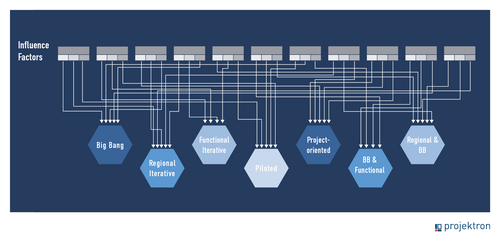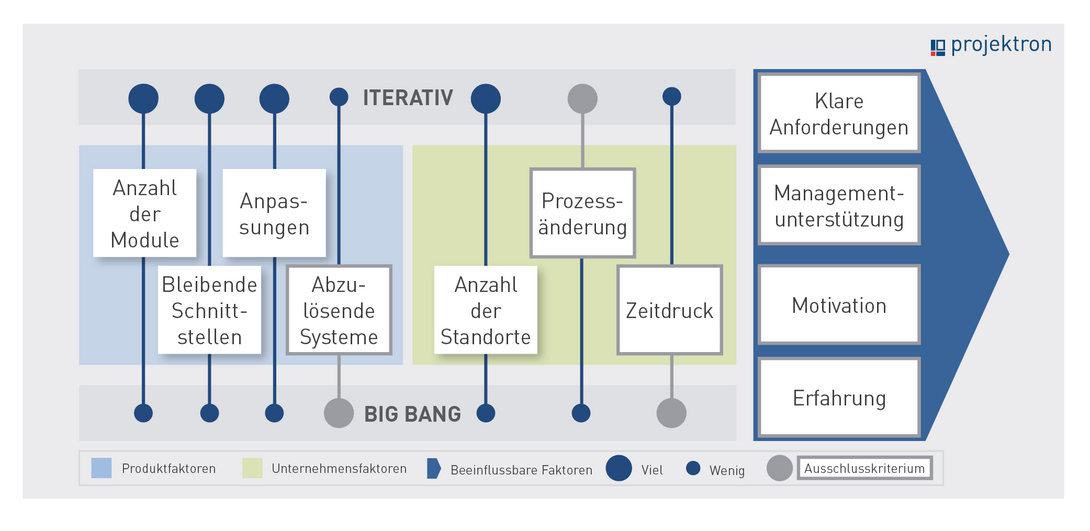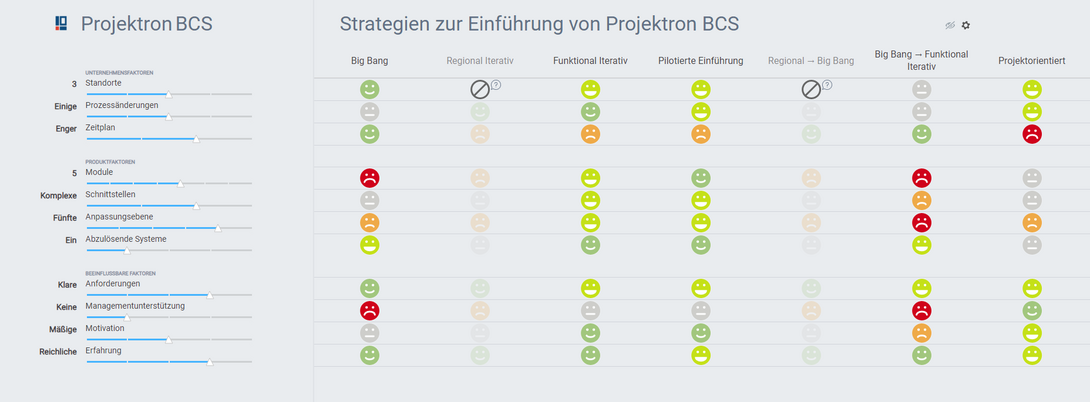03/23/2023 - Articles
Introducing software: These 11 influencing factors determine strategy
There are various strategies for introducing complex enterprise software. Depending on the specific circumstances of an organization, implementation strategies are more or less suitable. Essentially, eleven factors have an influence on the choice. Those who know these factors can influence them positively with appropriate measures and gain more freedom in the choice of implementation strategy.
Implementing software with strategy
When implementing complex enterprise software, choosing the appropriate implementation strategy is an important step that determines the success or failure of the implementation project. The selection of possible strategies is diverse:
Software implementation after Big Bang
With the big bang strategy, all software modules are activated for all users on a specific date. The new software replaces the legacy system holistically, so that users do not have to maintain processes in the new and legacy systems in parallel. However, the risk is high.
Project-oriented rollout
The project-oriented software rollout is a variant of the iterative, i.e. step-by-step software rollout. A small project team initially uses the new software as a tiger team in a typical company project. After appropriate adjustments, the rollout takes place company-wide.
Functional iterative implementation strategy
Functional iterative software introduction is a variant of the iterative, step-by-step introduction of modular enterprise software. In this approach, the individual functional modules of the new software are introduced into the company one after the other.
Regional/departmental iterative software implementation
Regional iterative software implementation and departmental iterative software implementation based on the same principle are variants of iterative, step-by-step implementation. A company introduces a software completely with all desired function modules successively at different locations or departments.
Combined implementation strategies
By combining big-bang and iterative process models, companies can develop customized strategies for introducing enterprise software that are precisely tailored to their individual needs. This enables more precise and flexible implementation.
Which influencing factors decide on the implementation strategy?
Based on practical experience, eleven key framework conditions can essentially be identified that determine which strategy is the most suitable for a company. These eleven factors can be divided into:
- Three given corporate factors
- Four company factors that can be influenced
- Four product factors
Given business factors
Some business requirements and goals that influence the selection of the appropriate implementation strategy can only be actively influenced by project managers from the software vendor and the company to a limited extent.
The number of company locations and departments
How many sites or departments will use the new software in the future? Companies usually introduce software for all their sites. Internationally, however, other regulations may take effect that a software does not support, so it is decided in the preparation phase to exclude international locations from the introduction. The number of sites also already excludes some implementation strategies, for example:
- With one site, it is not possible to roll out regionally iteratively or on a pilot basis.
- With two sites, it is not possible to implement regionally iteratively with subsequent big bang.
Process changes
When new software is introduced, there are usually process changes. Project managers should know how many and what process changes will occur as a result of the new system:
It may be that...
- the new software requires process changes (e.g., the new software only allows team members to track time on tasks)
- the new software enables process changes (e.g. new features allow risk management)
- process improvements were already planned beforehand, for which the change phase is now used by the software.
If the process changes involve the conversion of old processes, fewer measures usually need to be taken because the users are already accustomed to the processes. New processes, on the other hand, may mean that change management measures are necessary.
Value-adding processes should not be adapted to the new software under any circumstances. These should always be mapped by the new solution in such a way that they do not need to be changed.
A software introduction is also a change management process. It is important to get employees on board. Before introducing new structures, project managers must transparently present who will have to deal with which effects and changes. The term "change communication" describes the measures required to achieve this.
Process changes in the software introduction project lead to
- more effort, as they require description and explanation
- Increased project risk, especially in the case of dissatisfied users or management.
The more processes have to be adapted by the introduction of the software, the less suitable a Big Bang introduction is and the more iterative models come into question.
Time for the implementation project
Time is one of the factors of the magic triangle in project management, along with costs and content goals. Transferred to a software introduction project, this means that with the same costs and more time, more content-related goals can be achieved. Reducing the duration always increases the risk. An enforced schedule, for example, makes a project-oriented introduction impossible. The following aspects, for example, have an influence on the schedule:
- Deadline constraints: Expiring licenses, commitments to customers, etc.
- Cost savings with rapid rollout: licenses can be terminated earlier, better invoicing, etc.
- Legal framework: EU DSVGO as of May, obligation to record working hours, etc.
Experience shows: The effort and duration of a software implementation is almost always underestimated.
Product factors
The architecture and characteristics of the software itself influence the strategy selection with regard to four different factors. To assess these influencing factors, it may be helpful to involve a consultant from the software vendor. The four product factors are:
Number of modules
The more modules are to be introduced, the more complex and costly is not only the introduction process itself, but also the more unexpected resistance can arise among users, the more changes in existing workflows and processes are necessary, and the higher is the risk of failure.
Number of interfaces
The complexity and number of interfaces are important factors for a software implementation project. For big bang or regionally iterative implementations, all interfaces should be in place before the implementation begins. If the interfaces are complex and the software manufacturer has to program them on the core product, this can take so much time that, for example, the decisive advantage of a big bang introduction would not come into play at all. The more complex or numerous the interfaces are, the more likely it is that functional iteration or piloting should be used.
Some interfaces can be configured individually and can be scheduled more flexibly by the software manufacturer. New interfaces may need to be scheduled into their release planning dfor the standard. The release cycle can be a rough indicator of timing. For big bang implementations, interfaces should be tested with real data before the implementation deadline.
Depth of necessary customizations
In order to map individual processes in the company in the best possible way, customer-specific adaptations to standard software must be made. Individual enhancements to the software by the customer tend to be more error-prone than customizations by the software vendor. These errors must be found and corrected.
Quantity of systems to be replaced
The number of systems to be replaced is an important framework condition for a software implementation project if there is a requirement that one system should provide all project information for management. Only the big bang approach does not require the creation of temporary interfaces.
Accordingly, the more systems are to be replaced, the more effort is saved with the Big Bang approach and Big Bang with subsequent functional iterative introduction. In this case, the only effort required is for data transfer to the new software. If there are more than three systems to be replaced, the effort for the interfaces is too high for the regionally iterative introduction, the variant with regionally iterative with subsequent big bang and the project-oriented introduction.
Influenceable business factors
Four further factors are given, but can be influenced to a large extent. The software vendor's consultant and the company's internal project manager should try to actively influence them before and during the project to ensure a successful implementation. If they apply the right measures and turn the appropriate adjusting screws, they can improve the company factors that can be influenced to such an extent that
- a wider choice of implementation strategies is available, or
- significantly increase the probability of success of the selected implementation strategy.
Clear requirements and goals
Even before selecting software, a company should set out its requirements for the new system in writing. Equally important are the requirements of the future users, i.e., the employees. Work processes of different departments and cross-departmental workflows should also be documented and handed over to the software provider in a specification sheet.

If the requirements are unclear, a requirements workshop, for example, can help to identify or concretize requirements and goals.
Management Support
A software solution can change existing structures and power relationships within a company. If the project team installs a project management office (PMO) or a steering committee, management should support or at least approve.
Lack of management support will cause an implementation project to fail. For the Big Bang and Big Bang implementation strategies with subsequent functionally iterative implementation, a lack of management support is even a criterion for exclusion. Management support can be gained or retained by providing regular information on the status of the project. In particular, management should be informed about the project objectives at the beginning.

Management support can be gained and maintained through the following actions in project preparation and implementation:
- Description of project objectives (schedule, cost, social and non-objectives).
- Environment and stakeholder analysis
- Risk analysis with countermeasures
- Detailed project plan
- Communication plan
The management support factor also includes the time and cost factors that are not listed separately: If management support is high, more time is normally released for the project team. The same applies to the very often mentioned factor of costs or project budget.
If the project manager responsible for the software implementation is repeatedly withdrawn by management in favor of customer projects, an implementation project will drag on, cause higher costs and cannot be completed in the best possible quality.
However, the involvement of too high a management level can have a counterproductive effect. Particularly in corporate groups and holding structures, it is often easier and also completely sufficient to convince the site manager of the necessity of the software introduction. In this way, the unnecessary creation of bureaucratic hurdles can be avoided.
Motivation
The more motivated the future software users are, the smoother the introduction project will run. However, the larger a company is, the more difficult it is to push through a software introduction against the will of the employees. If the employees have a negative attitude towards the introduction, you should choose an iterative approach and continuously fight for more acceptance in parallel. The Big Bang strategy with subsequent functional introduction, for example, has no chance of success without employee motivation. To increase employee acceptance and motivation, employees should
- Understand the goals,
- recognize the benefits and
- be aware of the risks associated with the upcoming organizational changes.

The motivation of the user community can be increased by the following measures:
- Starting projects with simple or attractive modules (vacation management)
- Feedback rounds and regular consultation hours
- Communicating benefits on the intranet
- Workshops and customizations
- Training courses on the software
- Trainings in project management methods with certificate (PRINCE 2, GPM, PMI)
- Project marketing
Experience of the project team
The experience of the project team and project management is the all-important factor. If no experience is available, all methods carry a significant risk. The more experienced those responsible for implementation are,
- the better they assess risks,
- the more flexible they are in responding to unforeseen complications,
- the faster and more confident they are in making decisions, and
- the more complex introduction strategies can be chosen.
Experienced project managers know how to get management and users excited about the new software and how to meet many requirements. Inexperienced project managers should not be responsible for big bang or big bang implementation projects followed by functional iterative implementation.

Measures to increase the competence of the project team and the project management are:
- Training for the project team,
- Workshop on the implementation strategy
- Workshops on the project plan
- Training of the users by the software provider
- Consulting budget for support of the project manager
- Temporary support by experienced external project managers
In small and medium-sized companies, the phenomenon can often be observed that the selection of suitable software is delegated to interns or students. This is certainly possible and makes sense. However, the management of the implementation project should definitely be taken over by an experienced colleague.
If you do not have an appropriately experienced project manager in your team for your implementation project, contact us. We have accumulated decades of experience in the implementation of complex enterprise software and can support your project team individually, specifically and competently through training, workshops and in a consulting capacity.
How the expression of the factors determines the choice of strategy
The diagram illustrates how strong the influence of the various factors is on the choice of either iterative strategies or a big bang approach. The product factors (highlighted in light blue) are more strongly in favor of iterative approaches as the number of modules, adaptations or interfaces to be set up increases. However, if the number of systems to be replaced is very high and many interfaces therefore have to be set up temporarily from the old to the new system, this is a knockout criterion for iterative process models and suggests a big bang introduction.
Among the business factors that cannot be influenced (highlighted in green), time pressure is an exclusion criterion against iterative approaches. Many process changes speak against a big bang introduction. The more sites and users there are, the more suitable iterative approaches are.
The decisive factor for choosing the right strategy is usually the company factors that can be influenced. Each of these four factors can be improved with appropriate measures, so that other strategies can be considered. The tendency toward either iterative or big bang approaches thus results in a large number of concrete implementation strategies.
Strategy development with the expert tool
Weighing the eleven complex factors and recommending the appropriate implementation strategy is an enormously demanding task. We user consultants at Projektron GmbH use an expert tool for the introduction of Projektron BCS, which we developed specifically for this purpose.
The consultants fill in the input fields of the expert tool in workshops and in dialog with the customer company by determining appropriate values for the eleven influencing factors. The tool
- weights the criteria according to the conditions and requirements of the respective client company,
- visualizes the suitability of the strategies in a comparative manner and
- gives concrete recommendations for action in order to prepare the introduction in the best possible way and to optimize the conditions before the start of the project.
There are often several strategies that come into question under the given framework conditions. Managers and consultants should focus primarily on the four corporate factors that can be influenced. Those who have the opportunity to positively influence these factors for the implementation project automatically have more freedom in the choice of strategy.
Expert tool for strategy finding: advantages for customers and consultants
The expert tool helps consultants,
| objectively select the best possible implementation strategy for the customer's requirements, | |
| initiate targeted measures to optimize the influencing factors for the application of the respective strategy. |
The tool offers customers
| maximum transparency: it makes the consultant's recommendation comprehensible and creates acceptance for the measures among the workforce. | |
| the possibility of self-determination: it empowers the customer to make his own choice for the desired implementation strategy. |
Conclusion: Knowing and assessing the influencing factors - key to software implementation success
In the definition phase of the software introduction project, the choice of the appropriate introduction strategy is the central factor that determines the success or failure of the software introduction. Choosing an inappropriate strategy is one of the most common mistakes in software introduction. When deciding on a strategy, you must evaluate the complex interaction of various influencing factors and identify combinations of characteristics that exclude or make certain strategies mandatory.
This task is very complex and can only be decided internally within the company with a great deal of experience. If you are introducing new enterprise software, you should enlist the help of specialists and manage the introduction project together with the software provider's user consultants on a basis of trust.

About the author
Francisco Josué Artaza has been working at Projektron GmbH for 15 years, currently as marketing manager and user consultant. He is certified according to IPMA, PRINCE2 as well as Scrum Product Owner. He is an expert in software implementation strategies and has developed a tool that facilitates the selection of the appropriate strategy.


















